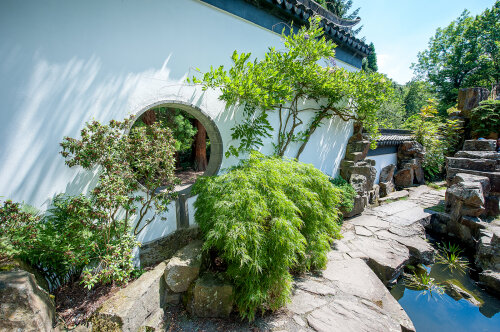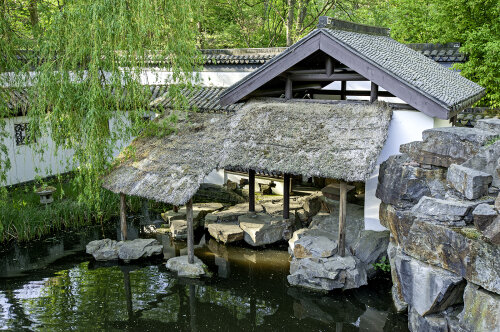Good news: From 01 October, the Chinese Garden will be open to the public again.
The Chinese Garden is located in the centre of the Botanic Garden. It covers an area of 1000 sqm. As one of the most beautiful and authentic Chinese gardens in Germany, this very special cultural gem is known far beyond Bochum. It was built in 1990 as a partnership gift from Tongji University in Shanghai to the Ruhr-University Bochum for its 25th anniversary. As a classical scholar's garden in the simple, natural southern Chinese style, the Chinese Garden offers a place of peace and meditation. Its name "Qian Yuan", which means "Qian's Garden", is a reference to the famous Chinese poet Tao Qian (365-427 AD), whose "Record of the Peach Blossom Spring" is known to everyone in China from an early age. The Chinese Garden in the Botanic Garden of the Ruhr-University is one of the most authentic Chinese gardens outside Asia. Thus, the Botanic Garden of the Ruhr-University Bochum has something very special to offer not only for those seeking recreation and science enthusiasts, but also for culturally interested visitors.
The name of the garden, "Qian Yuan" (Qian's Garden), goes back to the famous poet Tao Qian (365-427 AD), also known as Tao Yuanming. His "Report of the Peach Blossom Spring" has enjoyed great popularity in China for centuries. The beautiful story tells of a fisherman who by chance discovers a utopian land where people lead an ideal existence in harmony with nature, unaware of the outside world for centuries. In this story, Tao Qian expresses his longing for an ideal society and an idyllic life in harmony with nature. The "Qian Yuan" was built in the spirit of this philosophy.

The area outside the garden wall sets the mood for the meditative simplicity of the garden. The round openings in the wall, artfully designed windows, establish another connection between inside and outside. This is a reference to the specificity of the place, to the situation of "a garden within a garden". The wooden double door leads the visitor into the entrance hall. To the left, a walkway winds into the garden - over a covered bridge to the spacious main hall. From there, the visitor enjoys a view of the entire garden. To the right of the main hall, a few stone steps lead down to the water pavilion. At the back of the main hall, a smaller walkway branches off. As you take this small path, you will discover four brick carvings on the side wall. The main walkway now leads to a small niche in the wall, where an ancient fountain stands. The whitewashed wall and the old well offer a peaceful picture of village atmosphere, especially in autumn when the yellow chrysanthemums are in bloom. The next landscape, rugged rocks and a hut with a low thatched roof directly on the water, reminds us of a ferry station from ancient times. Further on, the path leads into a barren mountain landscape. Piled up rocks, in between which run rugged mountain paths. Suddenly, the path seems to end in front of a jagged rock face, yet it continues into a dark spring cave. Then the hiker steps back into the light. The path then leads to a small hexagonal pavilion. From there, the view once again encompasses the entire garden.
Architecture and nature harmoniously combine forms of tranquility and movement. The water: calm like a pond or a well, moving like a fountain or a waterfall. The pavilions invite visitors to linger quietly. On the walkways, which run through the entire complex, the visitor moves to the most beautiful viewpoints in the garden.

In China, a basic distinction is made between two different styles of garden design. The northern or imperial style is characterized by enormous dimensions and precious materials such as marble or colorfully glazed roof tiles. The Chinese Garden of the Ruhr-University is held in the southern Chinese style: simple materials - natural stone - wood and brick - and subtle colors such as white, black, gray and dark red. These rather small gardens with their poetic-picturesque scenery seem as if there is no other builder than nature itself. This garden style has been cultivated for centuries by scholars, artists and high officials.
The Chinese garden has been created on an area of about 1000 square meters. The pond occupies about half of this area. For the rock landscapes, 600 tons of rock were moved. They were piled up under the supervision of Chinese specialist builders. The typical materials such as wooden elements, bricks or tiles were produced in China, shipped to Germany and assembled here by native Chinese construction workers.
The texts were taken from the leaflet of the press office of the Ruhr-University Bochum. (Concept, layout, texts and photos: Monika Sprung, Babette Sponheuer & Wolfgang Stuppy)